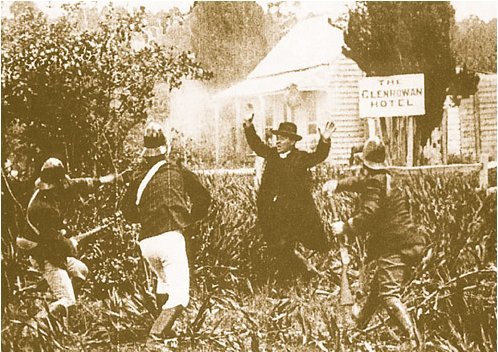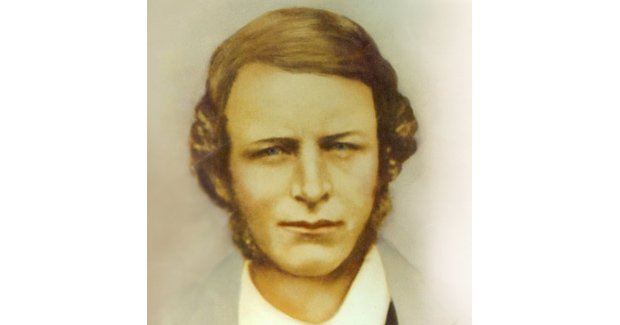Australia’s most notorious bushrangers

Murderers, madmen and outlaws feature prominently in Australia’s early colonial history. Many were escaped British and Irish convicts who chose to risk starvation and exposure in the harsh Australian bush rather than serve out sentences of hard labour for crimes in their home countries. Others were driven to a life of crime by poverty.
“These were people who felt oppressed by authority; they were a mixed bunch and they all had their own stories,” says Peter Fewster from the Old Melbourne Goal in Victoria. “Life as a convict was tough.”
As far as historical figures go, bushrangers had all the right ingredients for a great saga – drama, betrayal, murder, martyrdom, love and loathing. They generated significant social interest and people often followed their illicit endeavours salaciously illustrated newspapers.
Peter says that our obsession with bushrangers probably stems from an innate sense of rebellion against authority – origins of which are firmly rooted in our early colonial history as an outpost for convicts.
“The myth is that Australians are rebels – they’re strong individuals who are more known for being larrikins than law abiding citizens,” says Peter.
Here are some of Australia’s most notorious bushrangers:
1. The Kelly Gang

Screen grab from the 1906 film, The Story of the Kelly Gang – thought to be the world’s first feature length film, based on the notorious gang of bushrangers. (Image: Wikimedia)
Seared into the collective psyche of the Australian public is a curious sense of national pride towards the infamous Ned Kelly and his gang of bushranging outlaws, younger brother Dan Kelly and friends Steve Hart and Joe Byrne.
In their brief years as outlaws, the Kelly Gang murdered three police officers (Sergeant Michael Kennedy and Constables Thomas Lonigan and Michael Scanlan) and former-friend-turned-police-informant Aaron Sherritt. Between 1878 and 1880, they robbed the National Banks in Euora and Jerilderie.
“When they raided the bank at Jerilderie, they burnt the mortgage papers of small scale farmers who were indebted to the bank,” says Associate Professor Hamish Maxwell-Stewart from the University of Tasmania.”There’s a definitely political agenda to some of that activity.”
On 28 June 1880, the Gang made their final stand against police at the Glenrowan Inn, Victoria. The shootout lasted for half a day. After negotiating the release of hostages, police set fire to the building at around 3pm in an attempt to drive the bushrangers from its shelter.
Dan, Hart and Byrne died in the smoke and gunfire of the famous shootout. Ned was arrested and eventually hanged on 11 November 1880 at the Old Melbourne Goal, Victoria.
2. ‘Mad Dog’ Daniel Morgan

‘Mad Dan’ Morgan. (Credit: The National Library of Australia)
Some Australian bushrangers made their name from martyrdom, others from pure madness. In the case of ‘Mad Dog’ Daniel Morgan, the source of his infamy was definitely the latter.
In June of 1864, Morgan shot a bush worker near Albury, New South Wales. He asked another worker to ride for help, then, suspecting the man would ride to the police instead, shot him in the back. Months later, he shot dead a passing police officer just for saying “hello”.
In April of 1865, Morgan held up the Peechelba Station near Wangaratta and demanded that the owner’s wife play piano while he ate dinner. Upon leaving the station, he was shot by a stockman and died the following day.
3. Alexander Pearce

Sketch of Alexander Pearce, executed for murder on 19 July 1824. (Image: State Library of NSW)
Following through with the theme of madness is the disturbing Alexander Pearce, a convict who escaped the Macquarie Harbour Penal Colony in 1822 with seven others. Desperate, starving and disoriented in the bush for several weeks, three men abandoned the group while the other five began to murder and eat each other. Pearce was the only survivor.
He had made it as far as the Derwent River, Tasmania where he joined up with other bushrangers. Eventually, he was captured by authorities near Hobart and was returned to Macquarie Harbour.
Pearce attempted another escape shortly thereafter, this time with only one other convict. Again, he turned to cannibalism. When authorities finally caught him, they hanged him.
“If we want to demonise bushrangers, he’s a good example because of that psychopathic nature,” says Associate Professor Hamish Maxwell-Stewart from the University of Tasmania.
4. ‘Gentleman Bushranger’ Martin Cash

Martin Cash (1808-1877), convict and bushranger. (Image: Wikimedia)
From one moral extreme to another, ‘Gentleman Bushranger’ Martin Cash was easily one of Australia’s most considerate criminals. Cash was originally sent to Sydney from Ireland in 1827 for shooting a rival suitor in the buttocks. After serving seven years, he left for Tasmania as a free man only to be charged shortly after with theft and sentenced to a further seven years at the Port Arthur Penal Settlement.
During one escape attempt, Cash joined forces with experienced bushrangers George Jones and Lawrence Kavanagh to form a gang called ‘Cash & Co.’. Together, they stole from wealthy settlers and inns without violence, earning them the title of ‘Gentlemen Bushrangers’. Cash died in his bed at age 69.
5. ‘Bold Jack’ John Donohoe
Another Irish convict-turned-bushranger was ‘Bold Jack’ John Donohoe. He arrived in Sydney from Dublin as an 18-year-old in January 1825 to serve a life sentence on a settler’s farm in Parramatta.
Donohoe escaped with two other convicts and together they formed a gang known as ‘The Strippers’ – named after their technique for taking everything from wealthy settlers. All three were eventually captured and sentenced to death. Donohoe escaped while being transported to the jailhouse.
Eventually, he formed another gang of brazen bushrangers known as ‘The Wild Colonial Boys’. His bushranging days came to an end in a showdown with a contingent of soldiers and police on 1 September 1830. It was said that he shouted “come on” to the officers before dying from a shot fired by Trooper Michael Muggleston.
“Bushranging was very common in the convict era,” says historian Hamish Maxwell-Stewart. “Australia was a prison without walls.”
6. ‘Black Douglas’ Charles Russell
The legendary ‘Black Douglas’ Charles Russell was an English-born bushranger who held Melbourne and its surrounding areas to ransom during the 1850s. Russell preyed on those diggers travelling to and from the goldfields between Bendigo and Melbourne.
There are several accounts of victims being tied naked to a tree or fallen log with their boots full of bull ants, left to die a slow and excruciating death. He reportedly led a gang of 16 bushrangers who worked together in their marauding. Their camp was strategically located a few kilometres away from the Alma minefields in Maryborough, Vic.
Eventually, a frustrated group of nearly 200 diggers burnt their camp to the ground and overpowered Russell in May 1855. He was 75-years-old when he died in Bendigo jail in 1892.
7. Michael Howe
Former British soldier Michael Howe arrived in Tasmania in October of 1812 to serve a seven-year sentence for highway robbery. He bolted into the bush after a year on a settler’s farm, joining a gang of 29 escaped convicts and army deserters.
Howe quickly rose to become joint-leader of the bushranging bandits who ransacked the house of Magistrate Adolarius Humphrey at Pittwater in 1815 and terrorised the New Norfolk Settlement. Lieutenant Governor Thomas Davey declared Martial law for six months in an unsuccessful attempt to rid the colony of the bushrangers.
On 21 October 1818, Howe was clubbed to death by a fellow bushranger on the banks of the Shannon River. A reward for £105 for his capture had been offered by authorities.
8. ‘Captain Thunderbolt’ Frederick Ward

Statue of Captain Thunderbolt at the intersection of New England Highway and Thunderbolts Way, Uralla, NSW. (Image: Cgoodwin/Wikimedia)
Despite dubbing himself with a title more fitting for a comic book hero than an Australian bushranger, ‘Captain Thunderbolt’ Frederick Ward recruited children for armed holdups and shootouts with police.
Originally a drover from Paterson River, New South Wales, Ward was charged with horse thievery and sent to Cockatoo Island in August 1856 to serve 10 years of hard labour. After escaping on 11 September 1863, he settled into a life of armed robbery.
Among Ward’s juvenile accomplices was 16-year-old John Thomson, who was shot and captured by police during an armed robbery, 16-year-old orphan Thomas Mason, who was captured by police and convicted of highway robbery, and 13-year-old runaway William Monckton.
On 25 May 1870, Ward was shot-dead by Constable Alexander Walker at Kentucky Creek, Uralla.
9. ‘Brave’ Benjamin Hall

Bushranger Ben Hall, ringleader of Australia’s biggest gold robbery. (Photo: National Library of Australia)
‘Brave’ Benjamin Hall was a skilled stockman from Maitland, New South Wales who was driven to bushranging by a series of unfortunate events. In April 1862, he joined John Gilbert’s gang of bushrangers, who had been raiding Forbes since 1860.
Hall quickly rose in their ranks to become an efficient leader, ensuring his men were well armed and well mounted on racehorses that could outpace the bulkier mounts of the New South Wales police. Between 1863 and 1865, they committed more than a hundred armed robberies – without resorting to murder.
In October 1863, they herded the township of Canowindra into the Robinson’s Hotel for a three-day celebration. Music, food and drink were shared at the gang’s expense. Their infamy was such that the Felons Apprehension Act 1865 (NSW) was introduced – allowing authorities to kill bushrangers on-sight without the need for a formal trial.
At dawn on 5 May 1865, Hall was ambushed by state troopers at his camp near Goobang Creek, Lachlan River. He died under a hail of bullets.
10. Frank Gardiner

Escort Rock near Eugowra, New South Wales in Australia – The place where the gold escort was held up on 15 June 1862. (Image: Matilda/Wikimedia)
Frank Gardiner, born in 1830 Scotland and shipped out to Australia as a child with his parents, made an illustrious career out of horse thievery and highway robbery.
On 15 June 1862, Gardiner along with Ben Hall, John Gilbert and associates held up a gold escort travelling from Forbes to Bathurst. They stole over £14,000 worth of gold and bank notes – Australia’s biggest gold robbery.
In February 1864, New South Wales police traced Gardiner to his hideout in Queensland. He was arrested and sentenced to 32 years of hard labour in July. Ten years later, Governor Hercules Robinson granted him mercy and released him, subject to exile.
Gardiner lived in Hong Kong and Francisco before dying in Colorado in 1903.
“Colonial rule was constantly challenged by bushrangers – it was a major threat to the central administration,” says Dr Hamish Maxwell-Stewart from the University of Tasmania. “They were turning the tables on the convict state.”




